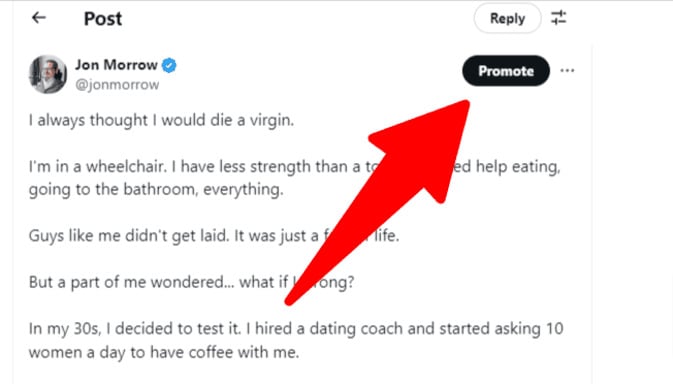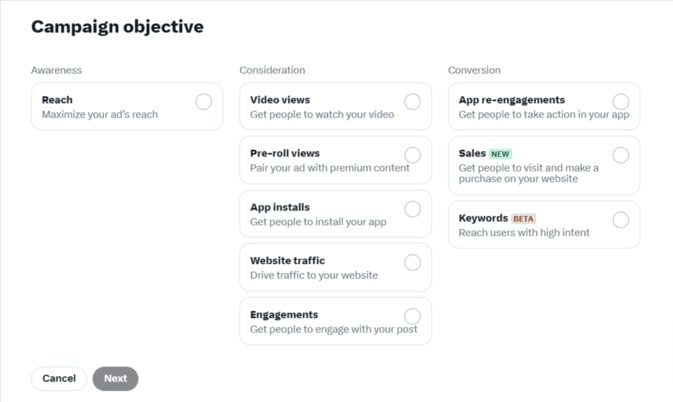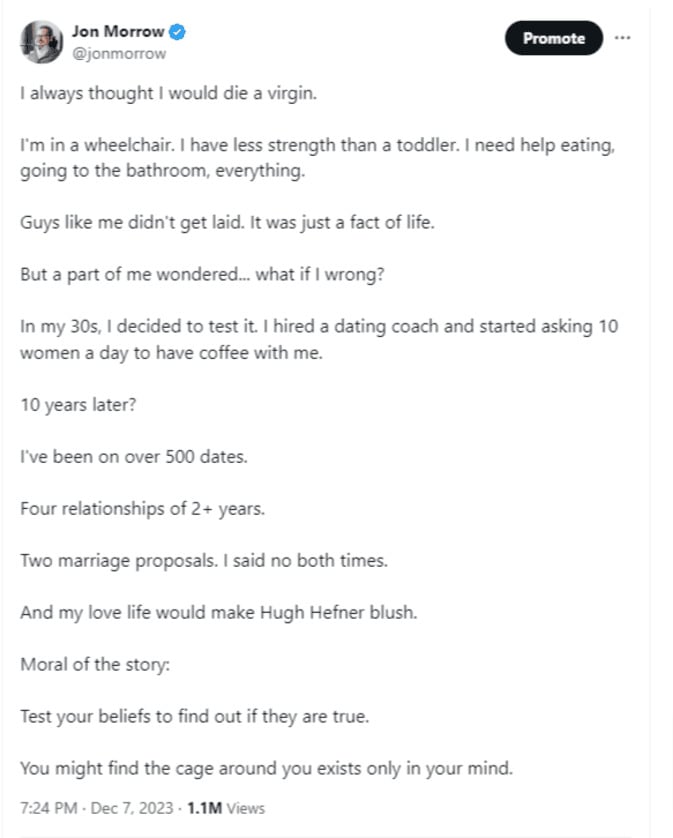If you’re using social media to grow your brand, you might have overlooked Twitter (rebranded as X) advertising.
It’s understandable. With so many platforms vying for your attention and budget, it’s easy to stick with what you know or what seems most popular.
You might think Twitter ads aren’t effective or necessary for your growth strategy. Perhaps you’ve had success with organic reach, or you’re focusing your efforts on other platforms.
But what if there’s an opportunity you’re missing?
What if Twitter/X ads could be the key to unlocking significant growth for your brand?
The Hidden Potential of Twitter/X Ads
Twitter/X ads offer some unique advantages:
- Targeted Reach to Engaged Audiences: Twitter/X’s user base is known for its engagement. When you advertise on Twitter/X, you’re not just reaching a passive audience. You’re connecting with people who are actively participating in conversations relevant to your niche.
- Cost-Effective Campaigns: You don’t need a massive budget to see results on Twitter/X. Even a modest investment can yield significant returns when targeted effectively.
- Amplification of Existing Content: Twitter/X ads allow you to boost your best-performing tweets. This means you can take content that’s already resonating with your audience and expand its reach dramatically.
How This Post Will Guide You
Whether you’re skeptical about Twitter/X ads or just unsure of where to start, this post is designed to give you everything you need to get started.
By the end of this post, you’ll have:
- A clear understanding of Twitter/X’s advertising ecosystem
- Strategies for growing your followers and boosting engagement
- Knowledge on how to maximize your return on investment
Unlike many of the other guides out there, I’ve spent thousands of dollars on the platform, so I’m speaking from experience here.
Miniature Case Study: How I Used Twitter/X Ads to Grow My Following
I recently decided to invest $2,000 in promoting my most popular tweets.
I carefully selected tweets that had already proven their worth through organic engagement, and then I used ads to dramatically increase their reach.
I also retargeted users who had engaged with these promoted tweets. The goal? Convert them into followers.
The Results: Thousands of New Followers

This strategy earned me around 2 million impressions. The follower numbers are also much higher than the 900 or so it reports.
So why did my ads work so well?
There is a flywheel effect. When you advertise a post that’s already getting organic traction, the ads result in more comments and shares, which results in even more traffic and followers.
In my case, I went from about 3,000 followers to 7,000 followers during the time I was running ads. It more than doubled my following.
And these weren’t just any followers. They were active Twitter/X users in the United States that were within my selected niche and who had engaged with my content. In other words, exactly the type of people you want following you.
Ever since running the ads, I’ve seen increased engagement on all of my posts, even ones that were not advertised. That’s because followers are continuing to engage with the content.
How to Duplicate This for Yourself
Let’s break this down into actionable insights:
- Identify Your Top-Performing Tweets: Look at your Twitter/X analytics. Which tweets get the most likes, retweets, and replies? These are your goldmines. They’ve already proven they resonate with your audience.
- Invest in Promoting These Tweets: Consider putting money behind your best content. This strategy is not about promoting every tweet, but rather amplifying your greatest hits.
- Retarget Engaged Users: Here’s where it gets smart. Don’t just promote and forget – follow up with users who engaged with your promoted tweet. Example: Someone liked your promoted tweet, so you target them with an ad inviting them to follow you.
The Next Steps
In the following sections, we’ll dive deeper into the specifics of Twitter/X ad campaigns. By the end of this post, you’ll have a clear roadmap for leveraging Twitter/X ads to grow your following, boost engagement, and amplify your brand.
Types of Twitter/X Ad Campaigns
When you’re ready to start advertising on Twitter/X, you’ll face a choice between three campaign types: Promoted Tweets, Simple, and Advanced. Let’s break down each option to help you decide which is right for your needs.
Promoted Tweets

Promoted tweets are the simplest type of ad campaign to run. You can boost a post with just a few clicks.
But I wouldn’t recommend it.
Yes, it’s simple, but you have no control over who you are targeting with your ad. There’s a good chance you will end up spending more money and get worse results than the other options covered below.
Simple Campaigns

Twitter/X has recently introduced Simple campaigns. This option is designed for:
- New advertisers
- Those who need to launch campaigns quickly
- Users who prefer a straightforward setup process
While Simple Campaigns are indeed easier to set up, you lose some powerful options. For example, tracking the value of sales based on your ads.
Is that a dealbreaker? It depends.
If you are running an e-commerce store, or you are promoting a book or other product on the front end, the simple setup probably isn’t going to work for you. On the other hand, if you are just boosting your posts to get followers (like I did), it’s totally fine.
Advanced Campaigns

Advanced campaigns offer more control and customization. They’re ideal for:
- Experienced advertisers
- Those who need detailed targeting options
- Campaigns with complex goals or multiple components
If you’re just boosting a few posts, you probably don’t need it. On the other hand, if you’re a major advertiser looking to make an ROI on your ads immediately, it’s probably a smart move. You’ll have far more control.
Campaign Objectives
Twitter/X organizes its campaign objectives into three categories: Awareness, Consideration, and Conversion. Let’s go through each category and the objectives within them.
Awareness
Reach:
- Objective: Maximize your ad’s reach
- Best for: Getting your message in front of as many people as possible
- Use when: Targeting a narrow audience you want to be in front of frequently. For example, past buyers.
Consideration
Video Views:
- Objective: Get people to watch your video
- Best for: Promoting video content, product demonstrations, or storytelling
- Use when: You have a video that’s doing well organically and you want to amplify its reach
Pre-roll Views:
- Objective: Pair your ad with premium content
- Best for: Associating your brand with popular video content
- Use when: You want to leverage the audience of established content creators
App Installs:
- Objective: Get people to install your app
- Best for: Mobile app promotions, game launches
- Use when: You’re promoting a new app or trying to boost installs for an existing one
Website Traffic:
- Objective: Drive traffic to your website
- Best for: Promoting lead magnets, a newsletter sign up, or other opt-in
- Use when: Your goal is to increase visitors to a specific web page.
Engagements:
- Objective: Get people to engage with your post
- Best for: Increasing likes, retweets, replies, and link clicks
- Use when: You have a regular post that’s already doing well organically and you want to boost it further
Conversion
App Re-engagements:
- Objective: Get people who have already installed your app to reopen it
- Best for: Re-activating existing app users or promoting new features
- Use when: You want to increase activity among people who have already installed your app
Sales:
- Objective: Get people to visit and make a purchase on your website
- Best for: E-commerce businesses, online sales promotions
- Use when: Your primary goal is to drive online sales
Keywords (BETA):
- Objective: Reach users with high intent
- Best for: Targeting users based on specific interests or search behaviors
- Use when: You want to reach people actively interested in topics related to your product or service
Choosing the Right Objective
To choose correctly, you have to know what you want to accomplish.
In my case, I wanted to grow my followers, so I promoted an existing post using an engagement objective, and then I followed up to everyone who engaged with another ad inviting them to follow and used the reach objective. At present, there is no follower objective.
If I wanted to grow my email list, on the other hand, I would normally use a website traffic objective.
Another somewhat unconventional option is to use a sales objective and then set the opt-in as the “sale,” so the advertising AI optimizes for more opt-ins.
And if you want to make sales, use the sales objective. This is going to be especially useful if you have a cheap front-end product that you are advertising to a cold audience. If you are selling a more expensive product to a warm audience, on the other hand, it might be worth trying the website click objective.
In other words, there’s also some experimentation involved. You may want to run the same campaign with different objectives and see which one gets the best results.
Targeting Your Audience
You’ve chosen your campaign type and objective. Now it’s time to ensure your ads reach the right people. Twitter/X offers a range of targeting options to help you connect with your ideal audience.
Demographic Options
Gender:
- What it does: Twitter/X allows you to target users based on their gender
- When to use it: Products or services specific to men or women
- Example: A women’s clothing brand targeting female users
Age:
- What it does: Targets users within specific age ranges
- When to use it: When you know the typical age range of your customers
- Example: Our customers range from 40-70 years old. Therefore, I would probably exclude anyone below the age of 35 from my ads.
Language:
- What it does: Targets users based on their language settings
- When to use it: Promoting content in specific languages
- Example: A Spanish language podcast targeting Spanish-speaking users
Location:
- What it does: Targets users in specific countries, states, cities, or even postal codes.
- When to use it: Local businesses or location-specific promotions
- Example: A restaurant chain promoting a new menu item in specific cities
Audiences and Interests
Custom Audiences:
- What it does: Targets your own audience based on what pages they have visited or their contact information.
- When to use it: Retargeting existing customers and leads
- Example: An e-commerce site targeting recent customers with a loyalty program offer
In my opinion, this is the most important type of targeting you should be doing, assuming you are active on Twitter/X. You’ll be reaching out to people who have already engaged with you and deepening the relationship. Because it’s such a small audience, it’s also relatively cheap to do.
Follower Look-alikes:
- What it does: Targets users similar to the followers of specific accounts.
- When to use it: Expanding your reach to potential new customers
- Example: A fitness app targeting users similar to followers of popular fitness influencers
Personally, I’ve found Follower Look-alikes to be ideal for cold ads. I can target other Twitter/X users I know my audience follows and siphon their audience.
Interests:
- What it does: Targets users based on their interests and behaviors on Twitter/X.
- When to use it: Reaching users interested in topics related to your product or service
- Example: A gaming company targeting users interested in video games and technology
I would be careful with these. They could work, but you are trusting Twitter/X to have categorized people correctly, and that might not always be true. Some interests could be dramatically more on-topic than others. Test small.
Movies and TV Shows:
- What it does: Targets fans of specific movies or TV shows
- When to use it: Entertainment-related promotions or tie-ins
- Example: A merchandise company promoting products related to a popular TV series
Conversation Topics:
- What it does: Targets users engaging with specific topics on Twitter/X
- When to use it: Joining relevant conversations or trending topics
- Example: A sports drink brand targeting users discussing fitness and workout topics
I’ve never tried this one, but I could see it being extremely useful if your brand relates to a trending topic.
Retargeting Past Engagements:
- What it does: Targets users who have previously engaged with your tweets
- When to use it: Re-engaging users who have shown interest in your content
- Example: An online course platform retargeting users who clicked on a previous ad but didn’t sign up
Super useful. Retargeting these people is the easiest way to get followers.
Retargeting Followers:
- What it does: Targets your existing followers with specific messages
- When to use it: Deepening engagement with your current audience
- Example: A software company promoting a new feature to its existing followers
Again, it’s a great idea when you start to get a few thousand followers. I would use this one to build your email list.
Combining Targeting Options
While each targeting option is powerful on its own, the real magic happens when you combine them. Here’s how you can layer different targeting options for more precise audience targeting:
- Demographic + Interest Targeting
- Example: Women aged 25-34 interested in fitness
- Use case: Promoting a new line of women’s athletic wear
- Location + Conversation Topics
- Example: Users in New York City discussing coffee
- Use case: Promoting a local artisanal coffee shop
- Custom Audience + Look-alike Targeting
- Example: Users similar to your email list subscribers
- Use case: Expanding your reach to potential new customers
- Age + Movies and TV Shows
- Example: Users aged 18-24 who are fans of a popular teen drama series
- Use case: Promoting merchandise related to the show
- Language + Follower Look-alikes
- Example: Spanish-speaking users similar to followers of popular Latin American influencers
- Use case: Promoting a Spanish-language podcast
- Retargeting + Interest Targeting
- Example: Past website visitors interested in technology
- Use case: Promoting a limited-time offer on tech gadgets
Remember, while it’s tempting to get hyper-specific with your targeting, be careful not to narrow your audience too much. You want to find the sweet spot between reaching a relevant audience and maintaining enough reach for your ads to be effective.
Crafting Effective Twitter/X Ads
You’ve set your campaign objective and targeted your audience. Now comes the crucial part:
Creating ads that capture attention and drive action. Let’s dive into the different ad formats available on Twitter/X and how to make them work for you.
Image Ads
Image ads are simple, yet powerful. They consist of a single image accompanied by text.
When to use:
- Showcasing products
- Sharing infographics
- Promoting events
Best practices:
- If promoting a discount on a cheap product, be direct in the ad and drive toward the sale.
- If you’re promoting your brand in general or a more expensive product with a consideration cycle, you don’t want your ad to look like an ad. You want it to look like content.
- If you’re advertising your personal brand, use images of yourself that your fans will recognize.
- For promoting products or educational concepts, use contrasting colors (i.e., blue and orange) to make the image pop.
- Ensure text on the image is minimal and readable.
- Stick to Twitter/X’s recommended image dimensions: 1200×628 pixels.
Here’s one of mine:

Video Ads
Video ads can be highly engaging, allowing you to tell a story or demonstrate a product in action.
When to use:
- Product demonstrations
- Behind-the-scenes content
- Customer testimonials
Best practices:
- Keep videos short (15 seconds or less for best performance)
- Add captions (many users watch without sound)
- Use an attention-grabbing opening frame
Example: A tech company creates a 15-second video showcasing the key features of their new smartphone, with text overlays highlighting each feature.
Carousel Ads
Carousel ads allow you to showcase multiple images or videos in a single ad that users can swipe through.
When to use:
- Displaying multiple products
- Telling a story in stages
- Showing before-and-after scenarios
Best practices:
- Use a consistent theme across all cards
- Put your best content first
- Use 2-6 cards for optimal engagement
Example: An e-commerce clothing store creates a carousel ad featuring different outfits for a seasonal collection, with each card showing a different look.
Lessons from Personal Experience
You’ve learned the ins and outs of Twitter/X advertising. Now, let’s bring it all together with some real-world lessons.
Remember my $2,000 investment in promoting popular tweets? Here’s what I learned:
1. Twitter Ads as a Catalyst for Growing Your Audience
Twitter ads aren’t just about paid reach – they’re a springboard for organic growth.
Here’s my most popular ad:

How it works:
- Promote content that’s already performing well
- A wider audience sees your best content
- Some of that audience sticks around
In my case, I plan to continue growing my personal brand this way. Yes, it costs money, but it saves a ton of time. Months or even years. To me, it’s worth it to spend $10,000 to have an engaged audience on Twitter/X.
Action step: Identify your top-performing organic tweets. Put a small budget behind promoting them. Watch what happens.
2. Use Retargeting to Turn Browsers into Fans and Customers
Don’t stop at the first interaction. Use retargeting to nurture potential customers.

How it works:
- Target users who’ve engaged with your content
- Show them ads that either get them to follow or join your email list
- Guide them further down your marketing funnel
For example, thousands of people engaged with a post about my dating life. I could easily put together a lead magnet with dating tips and then promote it with ads, building an email list of people interested in dating. From there, I could launch a coaching program and retarget everyone on my email list.
Action step: Set up a retargeting campaign for users who’ve engaged with your content in the last 30 days. Get them to follow you or join your email list.
Final Thoughts on Twitter/X Advertising Potential
Twitter/X ads offer unique opportunities for content creators and personal brands. Here’s why:
- Immediate reach: Your content gets in front of your target audience instantly.
- Flexible budgets: You can start small and scale up as you see results.
- Detailed targeting: Reach exactly who you want, when you want.
- Real-time engagement: Interact with your audience as they engage with your ads.
Now, would I be running ads if I were running an e-commerce store or local business? Probably not.
From what I can see, the real opportunity is just using ads to supercharge the growth of your brand on Twitter/X, and then retargeting to deepen the relationship.
The bottom line? Advertising on Twitter/X is worth a try.
So give it a shot — you might be surprised with the results!
The post Twitter/X Ads: A Detailed Guide after Getting 2 Million Impressions appeared first on Smart Blogger.

No comments:
Post a Comment